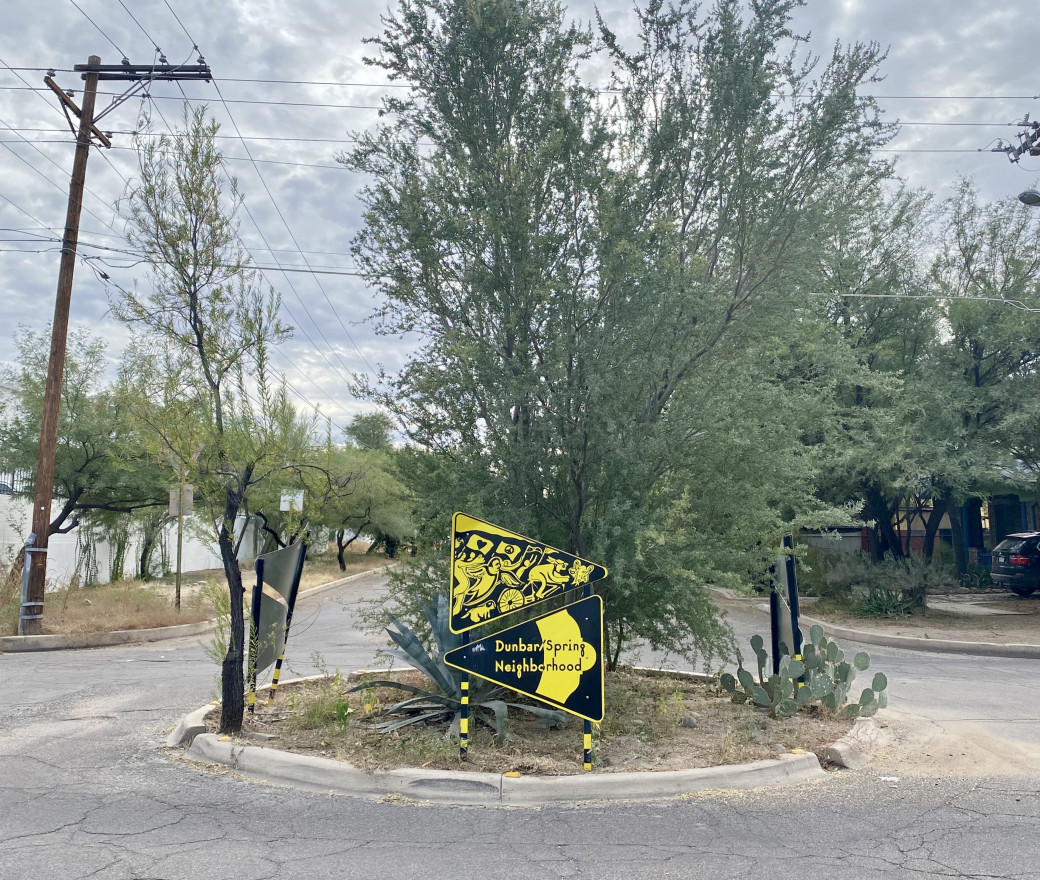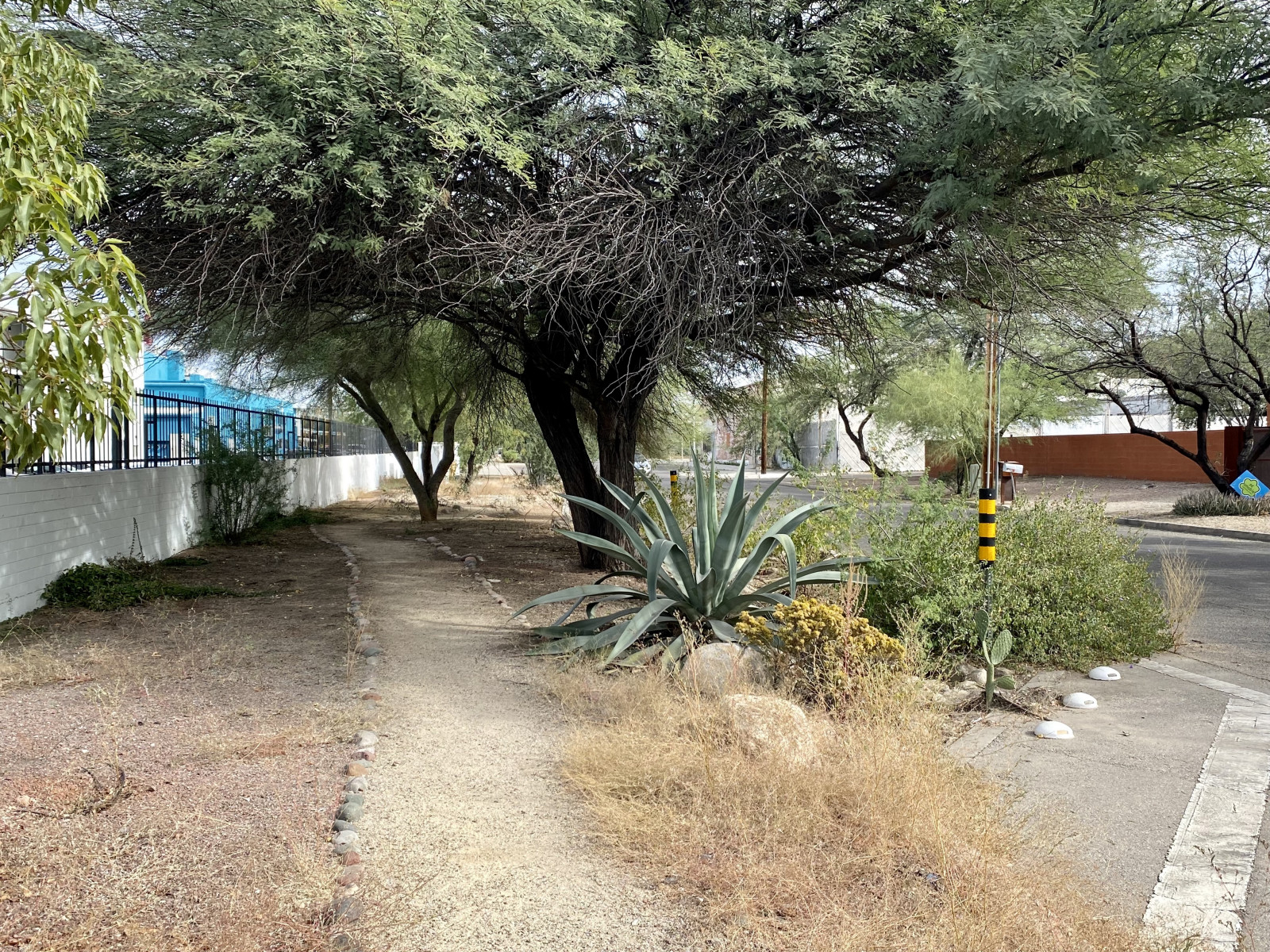
This roundabout is a type of green stormwater infrastructure, that collects stormwater for plants and people (Halley Hughes/University of Arizona).

This roundabout is a type of green stormwater infrastructure, that collects stormwater for plants and people (Halley Hughes/University of Arizona).
Eighteen years ago, Brad Lancaster picked up his rented jackhammer and began to demolish his neighborhood sidewalk––tearing up concrete and asphalt, digging a trench large enough to support a rainwater basin. As an experienced water conservationist and passionate advocate, Lancaster strived to give the sparse vegetation in his neighborhood of Dunbar Springs more water. The only problem… his curb cutting was illegal.
Instead of slapping sustainability vigilante Brad Lancaster with a fine, the city of Tucson listened to rallying cries of support from the members of the neighborhood and granted him an audience with the city planning division. The city used his expertise and example to rewrite the laws and begin a stormwater infrastructure program in Tucson, Arizona. This grassroots sustainability project was handed to Tucson Clean and Beautiful, a local non-profit, who then championed the spirit of renegade sustainability in several water harvesting projects.
One of the most successful projects is green stormwater infrastructure (GSI). The EPA states that “green infrastructure filters and absorbs stormwater where it falls.” GSI can range from rain barrels in backyards, trees placed in a basin along a street, roundabouts to collect water, or a rain garden.
Now, nearly two decades after Lancaster carved Tucson’s very first piece of GSI into a curb, the Southwestern U.S. faces unprecedented climate conditions––and the development of GSI is as pertinent as ever.
My home state of Arizona has been in an intense state of drought for 20 years (as long as I’ve been alive). Human-caused climate change has exacerbated a natural cycle of drought into a historic mega drought, making the Southwest the driest it has been since 1500 CE. I live in a water-limited environment, where the conservation of life’s most important resource is always at the forefront of planning decisions.
Arizona currently sources its water from the Colorado River through the Central Arizona Project (CAP), as well as several small running rivers, groundwater, and rainwater. The Colorado River gives 5 million people in Arizona water, providing for a whopping 80% of the population. Daily life in Tucson relies so heavily on the river that it was a crushing blow in August 2021 when lawmakers called an official drought on the Colorado River–– a historic first for the Colorado Basin. Lake Mead, the reservoir fed by the Colorado, hit critical and historic lows, triggering the drought. Consequently, water allocations must be cut for Colorado, Nevada, Utah, Arizona, New Mexico, tribal nations, and Mexico.
The first round of cuts will mostly be to the agricultural sector and may not affect the average city dweller; however, Arizona’s drought is predicted to get worse in the face of rising temperatures.
As Arizona looks to options for redressing this life-threatening change in water availability, Tucson may prove to be an oasis and an example to other cities.

Nichole Casebeer, the newly appointed GSI Project Manager at Tucson Clean and Beautiful (TCB), says she came to Tucson because it “…is a leader for water conservation in all of the Southwest, and maybe even in arid lands globally.” She is striving to continue the legacy of community-led development and leading the charge to expand the underutilized, incredibly affordable, sustainable, and beneficial alternative of stormwater harvesting. Even more than past leadership, Casebeer is shifting TCB toward a less top-down approach.
Casebeer spoke to me about drawing up the new strategic plan for TCB. She wants to target divested neighborhoods, which are those that have historically not been allocated resources from the city for development. She told me that, “(They’re) taking early steps to prevent gentrification and ensure that the positive effects of green stormwater infrastructure and beautification benefit the people who have historically lived in those neighborhoods.” These benefits include passively irrigating trees to create greener neighborhoods, reducing flooding, calming traffic, making streets safer, creating tree canopy to cool streets, and beautifying neighborhoods to create more vibrant communities.
Tucson’s sustainable water use is largely thanks to citizen behavior. Tucson citizens have cut water use with practical solutions like up-to-date fixtures, including faucets and toilets, and ecologically conscious lawns. However, Tucson’s population is growing, and as Lake Mead lowers, we will receive less and less water.
“On a net balance level, 100% of Tucson water’s use is Colorado River water,” said Tucson Water’s Superintendent of Public Information and Conservation, James MacAdam. So when our river allocation gets cut, so does our use, if we don’t want to deplete our precious aquifer.
While the drive for sustainable water use in Tucson grew organically, driven by grassroots projects, it is now also being championed by the city government, which plans to make stormwater a larger part of Tucson’s water allotment. In March of 2020, the city passed a tax on water use to help support new green stormwater projects.
The tax will collect about 3 million dollars every year to distribute to communities. Green stormwater infrastructure has immense social and economic benefits, and it’s now accessible to everyone in any neighborhood across the city.
Casebeer is excited about the future of Tucson’s leadership in water sustainability, both to help fight the effects of climate change and to improve the lives of people.
“The increased pride in neighborhoods that receive GSI is one of the greatest benefits,” she said. “It’s amazing what increased connection and uniting our urban fabric around such a vital resource can do.”
Author’s Note:
Stormwater may be an especially important resource to those of us in arid climates, but rainwater is an essential part of every natural and human ecosystem around the country. The Arizona Municipal Water Users Associations outlines essential actions that every citizen can take to make their rainwater clean and to make stormwater more efficient at the local level. Follow the actions outlined here to help reduce pollution and make water safer for humans, animals, and the environment.